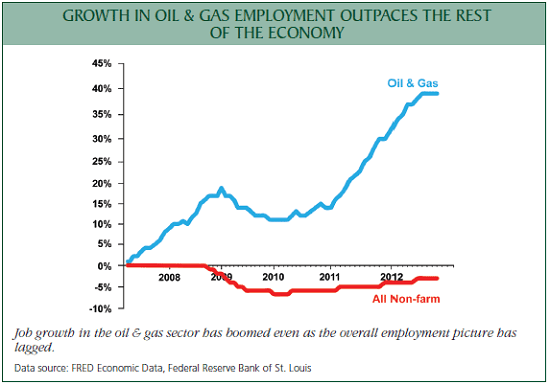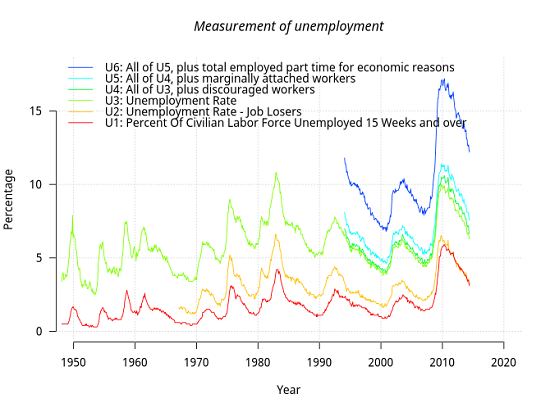It's officially silly season in U.S. politics leading up to midterm elections, with both parties stooping to distraction and hyperbole. As usual, some of the most misguided utterances so far have come from the White House and, specifically, from our own Commander-in-Chief.
Speaking to students and faculty at Northwestern University on October 2, 2014, U.S. President Barack Obama said of America's economic recovery, "It is a direct result of the American people's drive and determination... and the decisions made by my administration."
I totally agree with the first part of that statement. But the second part of it - the assertion that credit for whatever recovery we've had lies with his administration - is charitable, to put it mildly.
Love him or hate him, nearly 45% of the recovery can be traced to this one, single economic sector, and the president is actually dead set against it.
If you're like me, your eyebrows just shot up. Mine sure did when I first took a hard look at the data and ran the numbers.
That's because I love the underdog. Anytime something is unloved and unnoticed, I'm interested, especially if the numbers line up. And, boy, do they ever in this case.
A Recovery Tied Inextricably to America's Energy Revolution
At a time when overall U.S. employment has yet to return to its pre-recession levels of 2008, oil and gas exploration is the only sector that employs 40% more people now than it did then.
In fact, the growth is so strong that if you strip everything else away from the recovery President Obama insists he's created, there wouldn't be one for more than 139 million Americans as of September.
Even better - at least when it comes to investing potential - the president positively hates this sector, preferring instead to invest in so-called "green" alternatives, many of which haven't paid off. Solyndra, anybody?
And this begs the question: What would this historically weak "recovery" have looked like without the massive energy boom?
The ten top energy-producing states in America provide a clue.
Taken together, America's biggest energy-producing states are now Texas, North Dakota, Alaska, California, Utah, New Mexico, Louisiana, Colorado, Wyoming, and Oklahoma. According to Bloomberg, they have an average unemployment rate of below 5.3%, which includes North Dakota's sterling 2.8% - the lowest in the nation.
That's in contrast with the official national unemployment rate of 5.9%, which is itself artificially low as it reflects millions of people giving up their job searches rather than millions finding jobs. Never mind that the actual unemployment rate according to the U.S. Bureau of Labor Statistics is 12.6% when measured using the U-6. But that's a story for another time.
Of course, it stands to reason that if 10 energy-driven states have unemployment significantly below the national average, the remaining 40 with economies that aren't driven by energy booms must have unemployment that's well above it.
Keep in mind that these ten states are geographically and economically diverse. They can be found in the Pacific Northwest, the Great Plains, and in Dixie. Just about the only thing they all have in common is their role in the oil and gas boom.
As is so often the case, the simplest explanation is right on target. America's energy awakening has significantly boosted a recovery that otherwise would not exist.
Stocks to Buy: The Perfect Way to Play this Boom
Now, here's the thing. Eventually there's going to come a point where energy isn't hated, where investors stop beating up the president and stop running from the markets. And that's when the really big gains will happen.
I've seen this dozens of times over the course of my career. The closer the markets are to giving up, the closer we are to profits.
But energy is a tricky business. There are all kinds of ways to play this, ranging from equipment providers to exploration and everything in between.
Most are extremely volatile because they're tied to the dollar by virtue of the fact that oil is priced in dollars. That's why I like to look at businesses where there are still huge gains to be had even if the commodity itself falters.
My favorite two stocks to buy for this scenario are a special class of investment called Master Limited Partnerships, or MLPs for short. Essentially, these are special limited partnerships usually involving pipelines, storage, and transportation of energy. They're like a toll road for oil and natural gas that has to move no matter how much it costs, or how little for that matter.
I especially like them right now because the recovery that Americans created is going to need thousands of miles of new pipelines in the years ahead, so there's likely to be a whole lot of money flowing into the sector - pardon the pun - and that means undervalued choices are very attractive to my way of thinking.
Right now, Western Gas Equity Partners LP (NYSE: WGP) and its parent, Anadarko Petroleum Corp. (NYSE: APC) have been hit hard by the strengthened dollar, and APC in particular is still down 10% from its value a month ago - despite having sound management and an outlook that's strong as ever, temporary blips from a strengthened dollar notwithstanding. I also like the fact that they kick off yields of 1.90% and 1.20% respectively in an era where the Fed is determined to remain accommodative.
Now, a special note.
MLPs are technically a partnership issuing investment units that trade like stock. So there's special tax treatment that goes with owning one. Specifically, MLPs don't pay corporate income taxes, so those liabilities are passed on to investors who receive an annual K-1 or partnership statement that's similar to a 1099-DIV. That's taxed as income at your individual tax rate.
Actual cash distributions, on the other hand, are made to unitholders based on the MLP's distributable cash flow. They're actually not taxed when received, but considered reductions in your cost basis that create a deferred tax liability that shows up when you sell and MLP.
Generally speaking, you want to own MLPs in taxable accounts to avoid problems, but check with your financial professional to see what's most appropriate for your individual situation.
More from Keith Fitz-Gerald: Why Tesla Stock (Nasdaq: TSLA) Will Double in the Next 12 Months
About the Author
Keith is a seasoned market analyst and professional trader with more than 37 years of global experience. He is one of very few experts to correctly see both the dot.bomb crisis and the ongoing financial crisis coming ahead of time - and one of even fewer to help millions of investors around the world successfully navigate them both. Forbes hailed him as a "Market Visionary." He is a regular on FOX Business News and Yahoo! Finance, and his observations have been featured in Bloomberg, The Wall Street Journal, WIRED, and MarketWatch. Keith previously led The Money Map Report, Money Map's flagship newsletter, as Chief Investment Strategist, from 20007 to 2020. Keith holds a BS in management and finance from Skidmore College and an MS in international finance (with a focus on Japanese business science) from Chaminade University. He regularly travels the world in search of investment opportunities others don't yet see or understand.



